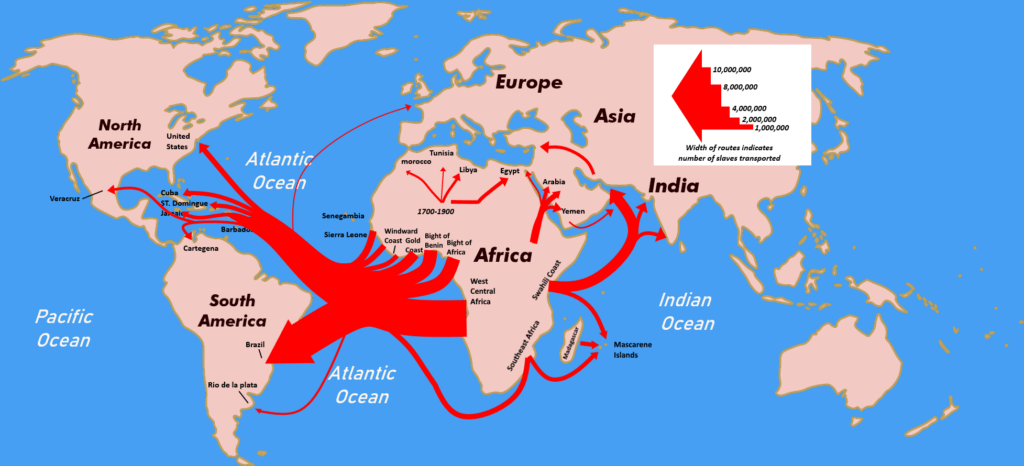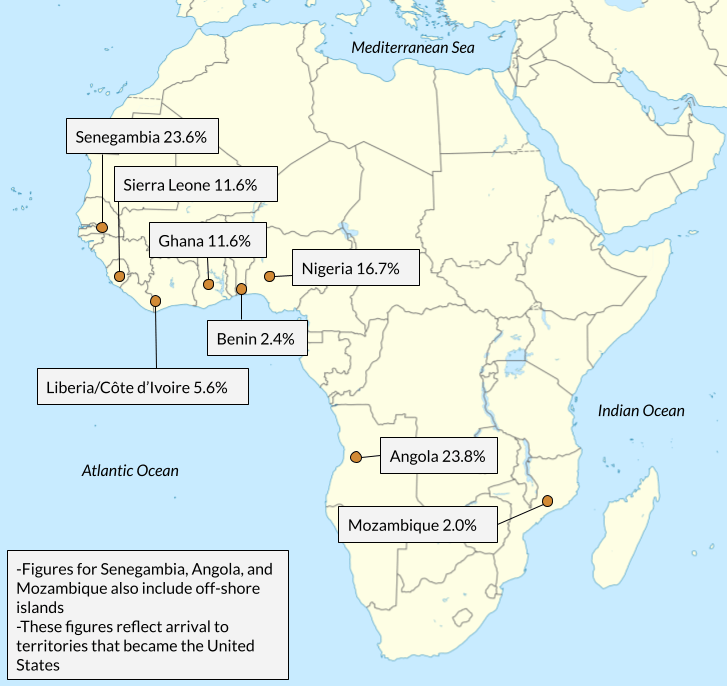What We Review
Departure Zones in Africa and the Slave Trade to the United States: A Study Guide
Introduction
The Transatlantic Slave Trade was a massive and devastating system of forced migration that profoundly shaped African diasporic history. Beginning in the early 1500s and lasting for over 350 years, this global enterprise involved the capture, sale, and transport of more than 12.5 million Africans to the Americas under brutal conditions. Although only about 388,000—roughly 5%—were brought directly to the land that would become the United States, the legacy of their forced labor and cultural survival had a lasting impact. The vast majority were taken to colonies in the Caribbean and South America, where mortality rates were often even higher and replacement through continued trafficking was more common.
Departure zones in Africa—such as the Bight of Benin, West Central Africa, and the Gold Coast—played a significant role in shaping the ethnic and cultural composition of enslaved populations in the Americas. These zones influenced the languages, belief systems, and cultural practices that would evolve within African American communities. However, the experience of enslavement fractured many of these identities and required people to adapt and preserve traditions under constant threat. Understanding the geography and complexity of the trade reveals not only the violent foundations of slavery in the United States but also the resilience of African-descended people in preserving heritage across generations.
Understanding the Transatlantic Slave Trade
What Was the Transatlantic Slave Trade?
The Transatlantic slave trade was a vast and violent system of human trafficking that operated from the early 1500s to the mid-1800s. European and American enslaving powers collaborated with local African intermediaries to capture and sell millions of Africans, many of whom were forced onto overcrowded ships along the West and Central African coasts. These captives endured the brutal Middle Passage across the Atlantic and were sold into slavery throughout the Americas, where they were compelled to perform labor-intensive work such as plantation agriculture, mining, and domestic service under inhumane conditions.
This forced migration profoundly shaped African American history by bringing a wide range of African cultures, languages, and belief systems into the Americas. However, it also violently disrupted countless families, communities, and traditions, leading to deep cultural loss and trauma. Before the nineteenth century, more people arrived in the Americas from Africa than from any other continent, making the African presence foundational to the demographic and cultural development of the New World. Despite the violent oppression they faced, enslaved Africans and their descendants preserved and adapted cultural practices in ways that continue to influence societies across the Americas today.
Scale and Geographic Scope of the Trade
Major Departure Zones in Africa
Departure zones, or regions where enslaved Africans were captured and placed on ships, were essential to the scale of the Transatlantic Slave Trade. Enslaved people mainly came from nine contemporary African regions:
- Senegambia
- Sierra Leone
- Liberia
- Côte d’Ivoire
- Ghana
- Benin
- Nigeria
- Angola
- Mozambique
Captives from Senegambia and Angola alone made up nearly half of those taken to mainland North America. Therefore, most African Americans can trace parts of their ancestry to these and other West and Central African regions. In these departure zones, the capturing process often began with local conflicts or raids. European and other traders purchased captives from local rulers or traders, then loaded them onto ships bound for the Americas.
Example: Map Analysis Activity
When analyzing a map of Africa, note how these nine regions lie along or near the Atlantic coast. Their geographic locations made it easier for slave ships to load large numbers of captive Africans.

African Slave Trade, CC BY-SA 4.0, via Wikimedia Commons
- Find West Africa and West Central Africa on the map above.
- Observe how their proximity to the ocean made them prime locations for the trade.
By completing this activity, it becomes clearer why some zones had higher numbers of enslaved individuals destined for the United States.
The Enslaving Nations
Who Were the Major Players?
Five main nations drove the Transatlantic Slave Trade:
- Portugal
- Great Britain
- France
- Spain
- The Netherlands
These countries established trading posts in African coastal regions. They actively sought labor for their colonies, driving up demand for enslaved Africans. Their motivation arose from the economic benefits of using forced labor to cultivate valuable crops, such as sugar, tobacco, and cotton.
- Portugal: Among the earliest participants in the slave trade and had existing relations with African kingdoms.
- Britain: Had extensive colonies in the Americas, particularly in the West Indies and North America.
- France: Engaged in the trade to supply labor for its Caribbean territories.
- Spain: Dominated large parts of South and Central America.
- The Netherlands: Used enslaved labor to advance its commercial and colonial ventures worldwide.
Example: British Case Study
Britain established fortifications along the West African coast, where slave ships departed carrying between 200 and 600 people. On board, enslaved Africans faced cramped conditions and high mortality rates. When they reached the Americas, they were sold in slave markets for plantation work. The British government profited through taxes, and many British merchants became wealthy, illustrating how the transatlantic slave trade fueled certain European economies.
Arrival Points in the United States
Key Arrival Destination

Charleston, South Carolina, served as the major port for incoming ships carrying enslaved Africans. In fact, it is estimated that 48% of Africans who arrived in the United States landed in Charleston. This port city quickly became the center of United States slavery, distributing newly arrived Africans to plantations throughout the South. Consequently, it grew in wealth and influence as more ships arrived, providing a steady supply of forced labor. However, slave ships docked in many cities on the East Coast of the United States, as far north as Portland, Maine.
Example: Statistics Review
If about 388,000 Africans reached the U.S. directly, and 48% of them entered through Charleston:
- 0.48 × 388,000 = 186,240
Thus, approximately 186,240 of the enslaved individuals who arrived in the United States came in through Charleston. Therefore, many African American families today may trace some lineage back to this port city.
Cultural Contributions and Community Development
Ethnic Diversity Among Enslaved Africans
Enslaved Africans did not come from a single ethnic or cultural background. Instead, they represented numerous communities such as the Wolof, Akan, Igbo, and Yoruba. Each group shared unique traditions, spiritual beliefs, agricultural knowledge, and musical styles. When these groups arrived in the United States, their cultural practices began to blend over time. As a result, African American communities reflect a rich mixture of multiple West and Central African cultures.
Moreover, nearly half of the Africans arriving in the United States originated from areas where Islam or Christianity was practiced. Consequently, religious customs brought from Africa combined with those adopted in the Americas, creating new spiritual expressions.
Conclusion
Departure zones in Africa and the slave trade to the United States highlight the vast scale and complexity of the transatlantic slave trade. Although only a small percentage of the total enslaved Africans arrived directly on U.S. shores, the impact on United States slavery was immense. Key arrival points like Charleston, South Carolina, served as entryways through which many cultural traditions arrived.
Furthermore, the top five enslaving nations—Portugal, Great Britain, France, Spain, and the Netherlands—competed to seize political and economic power. In the process, countless African societies were devastated. Nevertheless, people taken from diverse African communities carried forward their ancestral languages, religions, and social customs. Their descendants developed new cultural blends that became the foundation of African American life. Recognizing these facts deepens appreciation for the enduring significance of these historic events in African American history.
Required Sources and Their Importance
- Map Showing an Overview of the Slave Trade Out of Africa
- Map Showing the Regional Origins of Enslaved People Forcibly Transported to North America

These maps provide a visual representation of the departure zones in Africa and the paths followed by enslaving nations. They demonstrate the massive reach of the Transatlantic Slave Trade and explain why certain coastal areas became key hotspots. Additionally, the second map offers specific details about how many individuals came from each region, adding clarity to the distribution of African ethnic groups across the Americas. By studying these visual sources, it becomes clear how geography influenced routes, port locations, and the lasting cultural impact on African American communities.
Quick Reference Chart
| Vocabulary | Definition |
| Transatlantic Slave Trade | The forced transportation of over 12.5 million Africans to the Americas from the early 1500s to the mid-1800s. |
| Departure Zones | Regions in Africa where enslaved people were captured and placed on ships before crossing the Atlantic. |
| Enslaving Nations | Countries heavily involved in capturing and transporting enslaved Africans, including Portugal, Britain, France, Spain, and the Netherlands. |
| Charleston | The main U.S. port where nearly half of enslaved Africans arriving directly from Africa first landed, forming a core entry point to United States slavery. |
| Ethnic Groups (Wolof, Akan, etc.) | Distinct West and Central African groups whose cultural traditions, beliefs, and languages shaped the formation of early African American communities. |
Through this study, learners gain insight into when the transatlantic slave trade started, the scale of African departures, and how United States slavery evolved. By examining major departure zones in Africa and the primary arrival point of Charleston, students can better understand the origins of African American culture and the influence of African heritage across the country.
Sharpen Your Skills for AP® African American Studies
Are you preparing for the AP® African American Studies test? We’ve got you covered! Try our review articles designed to help you confidently tackle real-world AP® African American Studies problems. You’ll find everything you need to succeed, from quick tips to detailed strategies. Start exploring now!
Need help preparing for your AP® African American Studies exam?
Albert has hundreds of AP® African American Studies practice questions, free response, and full-length practice tests to try out.









